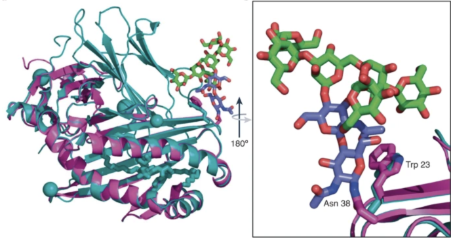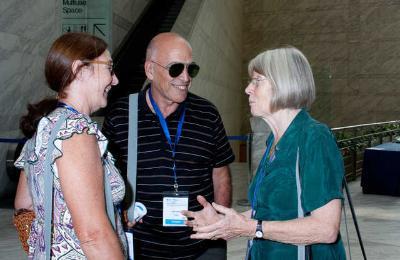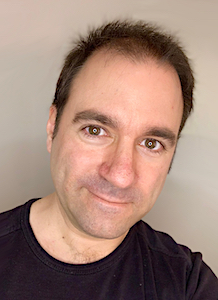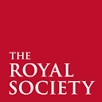Dr Jon Agirre
Royal Society University Research Fellow (assistant professor)
Tel: 01904 32 8252 Office: B/K/065 (Biology, Campus West)
Email: jon.agirre@york.ac.uk
Integrative structural glycobiology

In our group, we create computer programs that help model and understand atomic structures of biomolecules. We are particularly interested in carbohydrates and their interactions with proteins. We favour a combination of Python for prototyping, C++ for number crunching, HTML and Javascript for representation. We are a friendly, diverse and very international bunch, and our ambition is to put YSBL at the forefront of crystallographic and cryoEM method development.
Research
In the past six years, our team has produced new methodologies for building meaningful atomic models of glycans. A timely development, our Privateer software has been routinely used in the determination of SARS-CoV-2 structures that have informed the mRNA vaccines, antibody and inhibitor designs. But as the studies of the SARS-CoV-2 spike glycoprotein dynamics have evidenced, there is a big structural gap between what we can manage to resolve – even with the best methods – in an atomic structure and what is really there as determined by glycomics techniques – eg ~65 monosaccharides may be modelled into a Cryo-EM reconstruction of the SARS-CoV-2 spike glycoprotein, while 476 are detected by mass spectrometry. This is due to intractable problems such as microheterogeneity and flexibility – intrinsic to protein glycosylation – which hamper the process of structure determination.
However, for an atomic model of a glycoprotein to be mechanistically useful, it must contain the full-length glycans the glycoprotein has in vivo. This problem has now been taken to the extreme with the release of AlphaFold: a software method capable of predicting the structure of proteins with experimental-grade accuracy, but which leaves the crucial glycan components out altogether. New methods are urgently required to bridge the gap between the incomplete structures produced by the structural biology community, including AlphaFold, and the expectations of the mechanistic glycobiology field. In my team, we build on machine learning approaches to predict, graft and extend protein glycosylation onto either incomplete (X-ray crystallography and Cryo-EM) models, or AlphaFold protein structure predictions – all based on technology developed as part of my Royal Society University Research fellowship.
Publications
Selected Glycojones Team articles
- Agirre, J., Atanasova, M., Bagdonas, H., Ballard, C. B., Baslé, A., Beilsten-Edmands, J., ... & Yamashita, K. (2023). The CCP4 suite: integrative software for macromolecular crystallography. Acta Crystallographica Section D: Structural Biology, 79(6), 449-461.
- Dialpuri, J. S., Bagdonas, H., Atanasova, M., Schofield, L. C., Hekkelman, M. L., Joosten, R. P., & Agirre, J. (2023). Analysis and validation of overall N-glycan conformation in Privateer. Acta Crystallographica Section D: Structural Biology, 79(6).
- Atanasova, M., Nicholls, R., Joosten, R., & Agirre, J. (2022). Updated restraint dictionaries for carbohydrates in the pyranose form. Acta Crystallographica Section D: Structural Biology, 78(4):455-465.
- Bagdonas, H., Fogarty, C. A., Fadda, E., & Agirre, J. (2021). The case for post-predictional modifications in the AlphaFold Protein Structure Database. Nature structural & molecular biology, 28(11), 869-870.
- Rochira, W., & Agirre, J. (2021). Iris: Interactive all‐in‐one graphical validation of 3D protein model iterations. Protein Science, 30(1), 93-107.
- Bagdonas, H., Ungar, D., & Agirre, J. (2020). Leveraging glycomics data in glycoprotein 3D structure validation with Privateer. Beilstein Journal of Organic Chemistry, 16(1), 2523-2533.
- Atanasova, M., Bagdonas, H., & Agirre, J. (2020). Structural glycobiology in the age of electron cryo-microscopy. Current Opinion in Structural Biology, 62, 70-78.
For a more complete list, please check my Google Scholar profile.
Glycojones team

Phuong Thao Pham, Lou Holland, Jon Agirre, Jordan Dialpuri, Lucy Schofield. Photo credit: Luis Fuentes-Montero (Diamond Light Source).
- Jordan Dialpuri (joined in 2021 as a summer student). PhD student (BBSRC White Rose DTP), co-supervised with Kathryn Cowtan (Chemistry).
- Jake Kerrison (joined in 2022). PhD student (White Rose DTP ICASE fully-funded project with Eluceda ltd.), co-supervised with Michael Plevin (Chemistry) and Ian Eastwood (Eluceda ltd.).
- Ali Khan (joined in 2022). PhD student (CCP4 & Department of Chemistry), co-supervised with Kathryn Cowtan (Chemistry).
- Phuong Thao Pham (joined in 2023). PhD student (self-funded).
- Lucy Schofield (joined in 2022 as a summer student). PhD student (funded by CCP4).
- Lou Holland (joined in 2023). Postdoctoral Research Assistant (The Royal Society).
Alumni
- Haroldas Bagdonas (2018-2024). PhD graduate (The Royal Society), co-supervised with Dani Ungar (Biology)
- Manal Alzahrani (2019-2024). PhD graduate (Saudi Ministry of Education), co-supervised with Jamie Blaza and Gideon Davies (Chemistry).
- Amélie Hunter (2024). Summer student (The Royal Society).
- Alex Cherry (joined in 2023). MChem student.
- Rowan Gibbard (2023). Summer student (The Royal Society).
- Katie Tlusty (2023). MChem graduate (Chemistry).
- Charlie Campbell (2023). MBioChem graduate (Biochemistry).
- Mihaela Atanasova (2018-2023). PhD graduate.
- Jennifer Reece (2022). Summer student (The Royal Society).
- Henry Birch (2021-22). MChem graduate (Chemistry).
- Laura Smith (2021-22). BSc graduate (Biology).
- Niclas Krupp (2021-22). Erasmus graduate (Universität Heidelberg, Germany).
- Timothy Bell (2020-21). BSc graduate (Biology).
- William Rochira (2019-21). Masters by Research graduate (Chemistry).
- Iwan Hill (2019-20). MChem graduate (Chemistry).
- Alba Nin-Hill (PhD from Universitat de Barcelona, visitor 2018-19).
Teaching
Present:
- Group project (BIO00088M, 20 credits): I teach the 'Antibody mimetics' strand with my YSBL colleague Michael Plevin.
- Chemical & Synthetic Biology (CHE00037M, 10 credits): I run two workshops on molecular visualisation and analysis of protein-ligand interactions.
- Genes to Proteins (CHE00021I, 20 credits) and Protein Architecture & Action (CHE00022I, 10 credits): I do four lectures on Protein Structure and Diversity, which include an introduction to protein structure prediction. I also run a molecular graphics workshop.
- Core 4a: Biomolecules in Action (CHE00016I): I run small-group tutorials for Curie college.
- Data Science in Chemistry (CHE00047M): I coordinate the module and teach the 'macromolecular structures' sub-module.
Past
-
Core 3: Molecules & Reactions (CHE00017C): I used to run small-group tutorials for Dalton college.
Biography
I completed a degree in Computer Engineering (UPV/EHU, Donostia, Spain) in 2002, then moved on to doctoral training in structural virology, receiving my PhD in 2009 (Biophysics Unit, Bilbao, Spain). At the end of my PhD, I visited Professor Jorge Navaza at the Institut de Biologie Structurale Jean-Pierre Ebel in Grenoble (2009, funded by an EMBO short-term fellowship). I then obtained a 2-year fellowship (UPV/EHU) to do structural work on ion channels and their regulation by calmodulin, during which time I visited Professor Félix Rey at the Institut Pasteur in Paris (2011, funded by UPV/EHU) to finish some dangling work from my PhD.

Between 2011 and 2012, I received priceless one-to-one training in crystallographic and cryoEM method development from Professor Jorge Navaza, who was at the time visiting UPV/EHU (funded by Ikerbasque, Basque Foundation for Science). Informal and question-driven, these discussions were paramount in orientating my future career. In 2013, I went on to postdoctoral research with Profs Keith Wilson and Kevin Cowtan here in the Department of Chemistry where, in close collaboration with Prof. Gideon Davies, I produced some of the software I am currently recognised for. I also learned heaps of crystallography from Professor Eleanor Dodson, who naturally filled Professor Navaza's shoes and further expanded my training. In 2017, I was awarded a career-defining Royal Society University Research Fellowship to work on new methodologies for carbohydrate structure modelling, refinement, validation and representation. This fellowship has allowed me to build my own research group in York, and is providing me with outstanding training and career development opportunities.

Funding and support
My team's activities are supported (financially and/or logistically) by:


![]()

![]()
![]()
![]()
